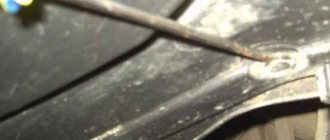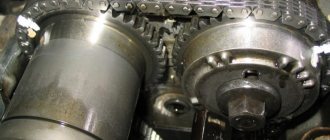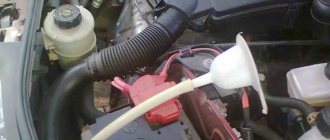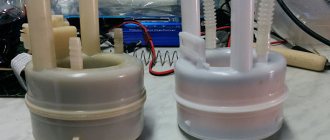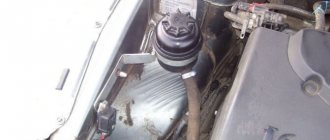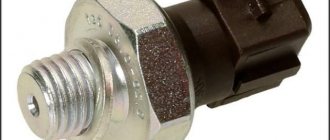Changing the oil in a variator is a procedure whose main task is to extend the operating period of a continuously variable transmission. Oil reduces the coefficient of friction between metal elements, promotes effective heat removal, and prevents contamination.
The X-Trail T31 uses transmissions from partner Jatco, in the JF011E modification. CVTs in Russia serve in extreme conditions, which also explains the attitude of most drivers towards crossovers, both SUVs, and the climate, regular exposure to low temperatures.
According to the regulations, the oil change in the Ixtrail variator occurs at around 90 thousand km. But miracles don’t happen, until the oil aging counter reaches 210 thousand conventional units, there will already be jelly in the box from waste.
To avoid a significant reduction in the operating period, the oil should be changed every 30 thousand kilometers traveled.
Immediate replacement is required in the following cases:
- discoloration, cloudiness, appearance of dirt;
- the appearance of a burnt smell;
- increase in viscosity, presence of metal shavings;
- the variator is noisy and vibrates;
- the car moves jerkily.
Checking the oil level
The driver needs to periodically monitor the oil level in the transmission to prevent it from becoming too low. Accurate readings can only be achieved after the box has warmed up.
Warming up means driving at an easy pace, without acceleration or jerking. In summer, a quarter of an hour is enough, in winter – half an hour. The verification procedure itself is performed according to the following algorithm:
- The machine is placed on a flat surface, the engine is idling.
- The variator control knob moves through all operating modes. The brake pedal is depressed, in each mode the handle remains for 10 seconds.
- The handle is set to the “Parking” position, the brake pedal is released.
- The measuring element is removed.
- The measuring element is inserted back and held for 10 seconds. The current level will be immediately clear from the oil trail and control marks. Labels max, min or serifs, low, high .
Lack or excess of oil can lead to serious consequences.
Checking the oil level should always precede the replacement, since the volume to be filled must be identical to that drained.
Preparation for work
Before you start changing the oil, professionals recommend warming up the car's gearbox. For this purpose, you need to drive 1 - 2 kilometers, then you can start working.
Photo source: www.drive2.ru/r/nissan/160170/
- You need to start by jacking up the front of the car and removing the driver's side wheel.
- The fender liner is being dismantled. It is important to note here that the fender liner is not removed completely, but only to the middle in the direction from the front bumper. Dismantling is carried out according to a simple scheme, since the fender liner is held in place by pistons and a hex bolt (1 piece). To operate, you will need a T20 star key. By removing the fasteners, the fender liner can be moved to the side.
Necessary tool
To complete the technical procedure you will need the following:
- Key “ten” with a set of heads.
- Jack (alternatively, install the Nissan on an overpass or inspection hole).
- Container for draining used oil.
- A composition for washing the pan and a magnet that allows you to remove the metal fraction.
- Funnel and personal protective equipment kit for convenience and safety.
The T31 CVT uses NS-2 oil ( KLE52-00004 ). It is also worth changing gaskets and filters, ideally with original elements.
Materials
1) NS-2 KLE52-00004 requires two cans. Total 8 liters. It takes about 6 liters to replace. There are analogues. 2) Pan gasket Nissan 31397-1XF0C or Mitsubishi 2705A015 3) Rubber oil cooler gasket Mitsubishi 2920A096 4) Fine filter Nissan 317261XF00 or Mitsubishi 2824A006 5) Coarse filter Nissan 3172 8-1XF03 I washed the old one 6) Nissan plug gasket 11026-01M02
Engine protection removed
Once access to the Nissan X-Trail pan is open, you can begin to remove it. The engine protection consists of two parts: plastic and metal.
First, the plastic protection is removed. This action is carried out quickly, since the fastening is carried out on 4 snap-on pistons. Removing metal protection will take more time and physical effort. The fastening here is made with metal bolts (4 in total), which are advisable to unscrew in a certain order:
- First, the bolts located next to the front bumper are completely unscrewed;
- the two rear bolts are unscrewed by half (simply loosened);
- the mortgages are removed very carefully;
- the rear bolts are completely unscrewed.
Attention! If the rear bolts are removed first or second, bypassing the “loosening” stage, then the embedded parts will definitely move along the beam. This will create unpleasant circumstances: you will have to jack up the rear of the car, which will slow you down in time.
content
First stage
We remove the battery. We remove the air duct. We disconnect the connectors from the engine and gearbox control units. On 2.0 engines, in front of the battery there are first the brains of the TCM box with one connector, behind the battery there are the brains of the ECM engine with 3 connectors.
Disconnects easily and intuitively. Using a 13mm head, unscrew the two bolts securing the brains of the box and move it to the side, there is no need to remove it, it won’t hurt
First of all, the vehicle is placed on a jack, inspection pit or overpass. The left front wheel is removed. The lining that protects the engine from shock loads is dismantled. Using a wrench and a 19mm socket, the plug is removed.
Beforehand, you need to place a container under the hole into which the waste technical fluid will drain.
After this, it is necessary to change the filter element installed in the variator cooling module. The algorithm of actions is as follows:
- The cover of the splash guard element is removed. Under the trim there is a pair of fixing bolts.
- While the technical fluid is drained, the battery and air duct are dismantled, and the connectors of the power unit and variator control unit are removed. All manipulations are carried out with a wrench with heads 10 and 13.
- The tubes through which antifreeze circulates are removed. This is done in order to thoroughly clean them of traces of old oil.
- The bolts securing the cooling module are unscrewed. To remove the filter, just move the cooler a little. The filter is changed along with the gasket; it is also subject to contamination and mechanical wear.
Replacement instructions
To change the oil in the Nissan X-Trail variator, you must do the following:
- Unscrew the drain plug in the variator pan.
- The oil will begin to drain, the color and consistency of which can determine the condition of the transmission. A dark shade, metallic inclusions and a specific smell of overheated grease indicate certain problems. It is advisable to carry out diagnostics at a car service center.
- As soon as the lubricant finishes draining from the hole, you need to unscrew the bolts securing the pan to the gearbox. There will also be some oil in the pan.
- The tray is removed and the magnets on its surface are inspected. If there are too many metal shavings, serious problems may occur.
- The oil pan is unscrewed.
- The old gasket is removed from the gearbox housing, and the gearbox itself is cleaned of dirt. The tray and the magnets located on it are washed separately.
- Next, a new oil intake and pan gasket are installed.
- The pallet is returned to its place and secured with bolts.
- Now you need to pull out the fastenings of the left boot, remove the boot itself and unscrew the screws at the bottom of the locker.
- Part of the locker is moved aside, after which the bolts on the heat exchanger are unscrewed.
- The heat exchanger slides to the side, allowing access to the filter.
- The filter is removed along with the rubber seal.
- A new filter is placed and the heat exchanger housing seal is changed.
- The heat exchanger is installed in its place, after which it is bolted.
- Locker elements are installed.
- Direct oil filling begins with the dipstick being pulled out of the guides to check the lubricant level.
- A funnel or special device is inserted into the opened slot, after which refueling begins.
Removing the pan, installing a new filter element (cleaning)
After draining the technical fluid, the oil pan is removed. It is secured with many bolts. When dismantling, you need to be careful and careful; traces of old oil may remain in the pan.
Carefully inspect for the presence of chips
The part holding the filter is removed with a socket head. The sealing element is dismantled. When cleaning, you can use a special carburetor cleaner or WD-40.
How to spot a fake
Often the buyer is offered counterfeit products. Using a counterfeit can be costly for the owner, since the counterfeit does not contain the necessary components and does not meet the specifications established for the transmission fluid.
A counterfeit can be identified by the following differences from the original product:
the shape and quality of the canister;
production of the main label - in the original it is fused into the outer wall of the container, but in the counterfeit it is simply pasted on;
the peculiarities of the information sticker on the back of the canister - it is made with a spine for reversal, freely unfolding and smoothed back (not sticking, but as if magnetized). The background for the font should not be gray, but white;
the execution of the lid - check for the presence of small breakdowns (traces from twisting on the conveyor);
the presence of an erasable code on the back of the canister, with the ability to check on the manufacturer’s official website.
Also, the buyer should be wary of the low price, which is 20 percent or more lower than the market average. To avoid counterfeiting, you need to buy oil from trusted suppliers.
We invite you to watch a video review of the differences between counterfeit and original Nissan oils.
Filling with new technical fluid
New oil is poured in small portions of approximately 150 milliliters. This allows it to be evenly distributed throughout the volume and fill the cavities. Checking the level after filling is carried out on a warm engine. The verification algorithm was discussed earlier.
Errors when filling out are acceptable. It is not always possible to achieve the desired level the first time. If necessary, the excess volume can be drained or, conversely, filled to the required levels.
Resetting the Nissan CVT lubricant aging counter using a simple scanner
The essence of the oil aging meter on the Nissan X-Trail T31 is that this is an algorithm embedded in the control unit for a continuously variable transmission. Therefore, there can be no talk of any replacement of the device.
The algorithm itself involves taking into account the operating parameters of the motor and variator, correction factors that are set by the manufacturer taking into account the task of preserving the resource of the box.
If you do not have a MUT-III designed for resetting, you can reset the performance degradation level using an adapter and ELM-327 version 1.5 . You should purchase such an adapter with caution, since unscrupulous sellers sell unsuitable devices under the working version (version 2.1).
Resetting the Nissan variator oil aging counter is carried out as follows :
- Download and install the program (for a smartphone or tablet);
- The adapter is inserted into the connector located near the hood release handle;
- The device is found via Bluetooth and the password 1234 .
- Data Monitor appears on the screen (the aging indicator is at the very bottom of the screen);
- In the main menu, press the “ Read CVTF DETERIORATION ” button, which is responsible for resetting;
- If zeroing does not occur, the procedure should be repeated (possibly several times).
Features of CVT gearboxes
We can say that in the domestic automobile market, cars with transmissions such as CVT are not common. So this is something of an innovation for Russian drivers. Therefore, let’s look at the design and operating features of this transmission.
The CVT does not have specific gear levels, like an automatic transmission or manual transmission. In a variator, the transmission coefficient, unlike all other types of gearboxes, changes smoothly. This is its main advantage.
The operating principle of a car variator is quite simple. There are two pulleys whose diameters can be adjusted. This is done by bringing together or removing their component parts. The force is transmitted from the drive pulley to the driven pulley using a V-belt. In cars, this belt is made of metal; another belt simply could not withstand such loads. It is often made from several cables so that it can take on a trapezoidal, or wedge-shaped, shape during operation.
As soon as the conical surfaces of the side blocks of the drive pulley come closer together, its diameter increases. He pushes the belt closer to the edge, which takes on a wedge-shaped shape. The gear ratio increases. At this time, the driven pulley reduces its diameter. The side blocks move apart, the belt drops to a lower level, closer to the center of the pulley. On the driven pulley side, the gear ratio decreases. The slave sets the wheels of the car in motion. This is how the car accelerates – smoothly and gradually. This process is shown more clearly in the figure.
At the minimum gear ratio, the side surfaces of the pulleys move away from each other so much that the belt takes on a rectangular shape. Their approach or removal is controlled by an electronic system driving a hydraulic oil drive specially designed for this purpose.
The Nissan X-Trail design uses two types of continuously variable automatic transmission, or CVT, from the Japanese company Jatco. Two modifications are installed on crossovers: RE0F06A, which began production in 1999, and JF011E (RE0F10A) produced in 2005. The latter is the undisputed world leader among continuously variable automatic transmissions.
Useful information
When working, you need to remember the following:
- The average volume of oil to be replaced is 7 liters, so you need to buy the appropriate amount in advance based on this value.
- When tightening bolts, you should follow the “crosswise” pattern and accurately control the force to avoid mechanical deformation.
- If there is no funnel, you can carefully fill in new oil by feeding it along the dipstick.
The first few kilometers after changing the oil, you should not subject the transmission to heavy loads. Driving at an easy pace will allow the oil to fill the entire space of the variator and be distributed over all parts that are in mechanical contact.
Practical advice on choosing oil in a Nissn X-Trail automatic transmission
The oil in the automatic transmission must meet all the parameters of the original oil that is filled from the factory. If you fill in an analogue and not the original, then do a complete lubricant change. Otherwise, the two types of lubricant will mix, and this will lead to failure of the automatic transmission.
The valve body and solenoids of the Nissan X Trail variator love the original clear oil.
Original oil
The original oil has all the necessary additives necessary for the normal functioning of the machine. The original for the Nissan X Trail automatic transmission is the Nissan Matic S with catalog number KLE5200004EU. I recommend filling only the original into the variator.
Read
Typical problems and repairs of automatic transmission f4a42
A lubricant with NS 3 approval is suitable for an automatic transmission.
This type replaced the discontinued Nissan Matic J. It is red in color. Sold in plastic bottles of 1 and 4 liters. Article number 999MP-MTS00-P. Made in the USA.
The liquid has a high price. Therefore, many car owners are looking for analogues. Similar oils can be used, but not counterfeits. Analogues must meet the standards and pass the same tests that the original passed.
Analogs
As an analogue in the Nissan Xtrail automatic transmission, the following gear oil Nissan Matic D or Zic ATF Multi with the Dexron III standard is suitable. No liquids of any kind should be added. Otherwise you risk losing the box.
When purchasing for a variator or hydraulic automatic, look at the designations. The fluid that is suitable for a CVT gearbox is designated CVT. The oil that is suitable for filling into the machine is designated ATF.
Consumables
During the repair process we will need materials and tools such as:
- original NISSAN CVT NS-2 lubricant specifically for Nissan X-Trail T31. In the catalog its number is KLE5200004EU. For the later model X-Trail T32, NS-3 grease must be used;
- two filters: one coarse filter (32101EE), the second fine filter (2824A006);
- gaskets that are necessary for the variator pan (313971XF0C), as well as for the oil cooler (number 2920A096);
- a lot of rags and a container where the used lubricant will be drained (the container must have a volume of at least 8 liters).
